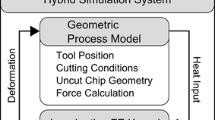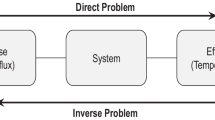Abstract
From today’s point of view the modelling of machining operations is a promising tool to extend the productivity and the precision of future industrial manufacturing. The importance of predictive simulation and compensation of thermally induced workpiece deformation during machining is especially important in dry machining because of the absence of cooling lubricants. Since the simulation results mainly depend on the boundary conditions of the model, a detailed knowledge of them is necessary. In this case the most important boundary condition is the intensity and possibly the distribution of the surface heat flux representing the heat flow into the workpiece resulting from the chip formation. The surface heat flux cannot be measured directly. One possible way to determine surface heat fluxes is to employ a thermal model of the machining process and match simulated and measured time and space dependent temperature fields. This procedure is time-consuming and is in most cases subjective because the congruency of temperature fields is rated manually, e.g. by the position of single isotherms. Therefore an enhanced method for the determination of surface heat fluxes is proposed in this paper. The method is based on nonlinear optimisation techniques and a simple finite difference scheme for numerical solution of the heat equation (WORHP-FDM). The procedure is objective between repeat measurements and works in a fully automated manner. The implementation is validated by the comparison to an analytical solution of the moving heat source based on the model of Carslaw and Jaeger and then applied to measured thermal images from milling experiments.









Similar content being viewed by others
Abbreviations
- T CJ (x, y) (°C):
-
Temperature field simulated with the model by Carslaw and Jaeger
- \(\dot{q}_{CJ}\,(\hbox{W/mm}^2)\) :
-
Surface heat flux used in the model by Carslaw and Jaeger
- v f (mm/min):
-
Feed velocity/heat source velocity
- f z (mm):
-
Feed per tooth
- \(\dot{q}_{WORHP}\,(\hbox{W/mm}^2)\) :
-
Surface heat flux identified by the WORHP-FDM approach
- v c (m/min):
-
Cutting velocity
- a p (mm):
-
Depth of cut
- a e (mm):
-
Width of cut
- P el.meas (W):
-
Measured spindle power
- c p (J/kg K):
-
Specific heat capacity
- ρ (Mg/m3):
-
Mass density
- k (W/m K):
-
Thermal conductivity
- a (mm2/s):
-
Thermal diffusivity
- T k i,j (°C):
-
Discrete temperature identified by the WORHP-FDM approach
- \(\bar{T}_{i,j}^k\,(^{\circ}\hbox{C})\) :
-
Discrete data temperature
- g (°C/m):
-
Neumann boundary values
- X :
-
Optimisation variable
- FDM:
-
Finite difference method
- NLP:
-
Nonlinear optimisation problem
- SQP:
-
Sequential quadratic programming
- NAND:
-
Nested analysis and design
- SAND:
-
Simultaneous analysis and design
References
Tönshoff HK (2003) Spanen, grundlagen. Springer, Berlin
Brinksmeier E, Sölter J (2009) Prediction of shape deviations in machining. CIRP Ann Manuf Technol 58:507–510
Furness R, Sebastian A, Stoll A (2007) 100 Prozent MMS in der Getriebegehäuse-fertigung. Werkstatt und Betrieb 9:80–85
Müller-Hummel P (2000) Auf Kühlschmierstoffe verzichten. WB Werkstatt und Betrieb 133(6):76–79
Heisel U, Storchak M, Eberhard P, Gaugele T (2011) Experimental studies for verification of thermal effects in cutting. Prod Eng Res Devel 5:507–515. doi:10.1007/s11740-011-0312-3
Loehe J, Zaeh MF, Roesch O (2009) In-process deformation measurement of thin-walled workpieces. Procedia CIRP 1:546–551
Joliet R, Byfut A, Kersting P, Schröder A, Zabel A (2013) Validation of a heat input model for the prediction of thermomechanical deformations during NC milling. Procedia CIRP 8:403–408
Klocke F, Lung D, Puls H (2013) FEM-modelling of the thermal workpiece deformation in dry turning. Procedia CIRP 8:240–245
Puls H, Klocke F, Lung D (2012) A new experimental methodology to analyse the friction behaviour at the tool-chip interface in metal cutting. Prod Eng Res Devel 6:349–354. doi:10.1007/s11740-012-0386-6
Schindler S, Zimmermann M, Aurich JC, Steinmann P (2013) Modeling deformations of the workpiece and removal of material when turning. Procedia CIRP 8:39–44
Dyck M (2007) Beitrag zur analyse thermisch bedingter Werkstückdeformationen in Trockenbearbeitungsprozessen. Dr. Ing. Dissertation, WBK
Pabst R (2008) Mathematische Modellierung der Wärmestromdichte zur Simulation des thermischen Bauteilverhaltens bei der Trockenbearbeitung. Dr. Ing. Dissertation, WBK
Richardson DJ (2006) Modelling of cutting induced workpiece temperatures for dry milling. Int J Mach Tools Manuf 46:1139–1145
Biermann D, Iovkov I, Blum H, Rademacher A, Taebi K, Suttmeier FT, Klein N (2012) Thermal aspects in deep hole drilling of aluminium cast alloy using twist drills and MQL. Procedia CIRP 3:245–250
Biermann D, Iovkov I (2013) Thermal aspects in deep hole drilling of aluminium cast alloy using twist drills and MQL. Procedia CIRP 3:245–250
Chen M (2003) Experimental research on the dynamic characteristics of the cutting temperature in the process of high-speed milling. J Mater Process Technol 138:468–471
Pittala GM (2011) A new approach to the prediction of temperature of the workpiece of face milling operations of Ti-6Al-4V. Appl Therm Eng 31:173–180
Sölter J, Gulpak M (2012) Heat partitioning in dry milling of steel. CIRP Ann Manuf Technol 61(1):87–90
Büskens C, Wassel D (2013) The ESA NLP solver WORHP. Modeling and optimization in space engineering. In: J. D. Pintér (Hrsg.), Springer optimization and its applications, vol 73. Springer, Berlin
Jaeger JC (1942) Moving sources of heat and the temperature at sliding contacts. Proc R Soc N S W 76/3:203–224
Carslaw H, Jaeger JC (1959) Conduction of heat in solids. Oxford Science Publications, Oxford University Press, Oxford
Marsal D (1989) Finite Differenzen und Elemente. Springer, Berlin
Ludwig R (1971) Methoden der Fehler- und Ausgleichsrechnung 2nd edn. Deutscher Verlag der Wissenschaft, Berlin
Geiger C, Kanzow C (2002) Theorie und Numerik restringierter Optimierungsaufgaben. Springer, Berlin
Arora JS, Wang Q (2005) Review of formulations for structural and mechanical system optimisation. Struct Multidiscip Optim 30(4):251–272
N.N. (1997) Taschenbuch der Stahl-Eisen-Werkstoffblätter. Verein Deutscher Eisenhüttenleute, Verlag Stahleisen GmbH, Düsseldorf
Acknowledgments
The results in this paper were obtained within the DFG priority programme 1480 “Modelling, Simulation and Compensation of Thermal Effects for Complex Machining Processes”. The authors thank the Deutsche Forschungsgemeinschaft (DFG) for the financial support.
Author information
Authors and Affiliations
Corresponding author
Rights and permissions
About this article
Cite this article
Wernsing, H., Gulpak, M., Büskens, C. et al. Enhanced method for the evaluation of the thermal impact of dry machining processes. Prod. Eng. Res. Devel. 8, 291–300 (2014). https://doi.org/10.1007/s11740-013-0523-x
Received:
Accepted:
Published:
Issue Date:
DOI: https://doi.org/10.1007/s11740-013-0523-x




